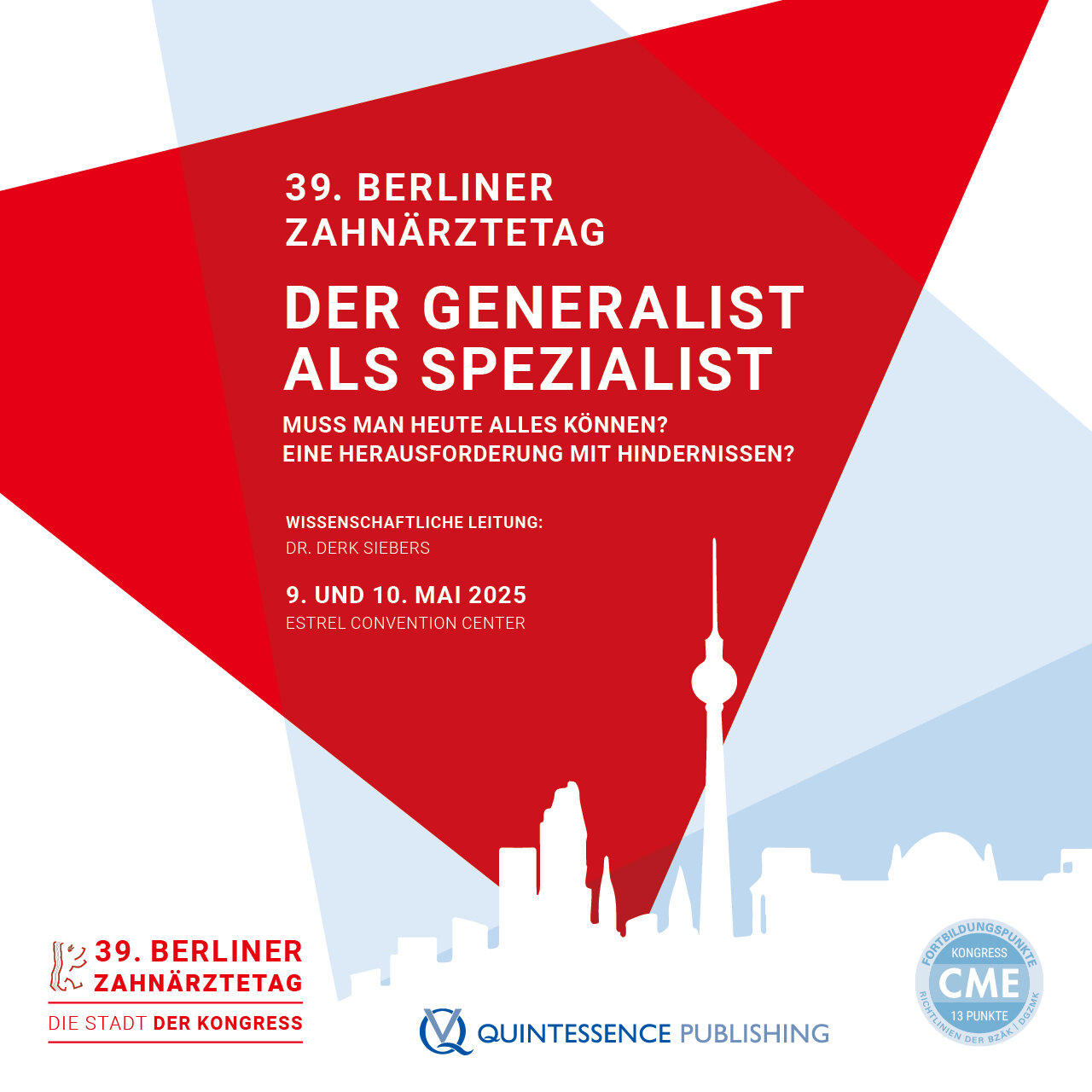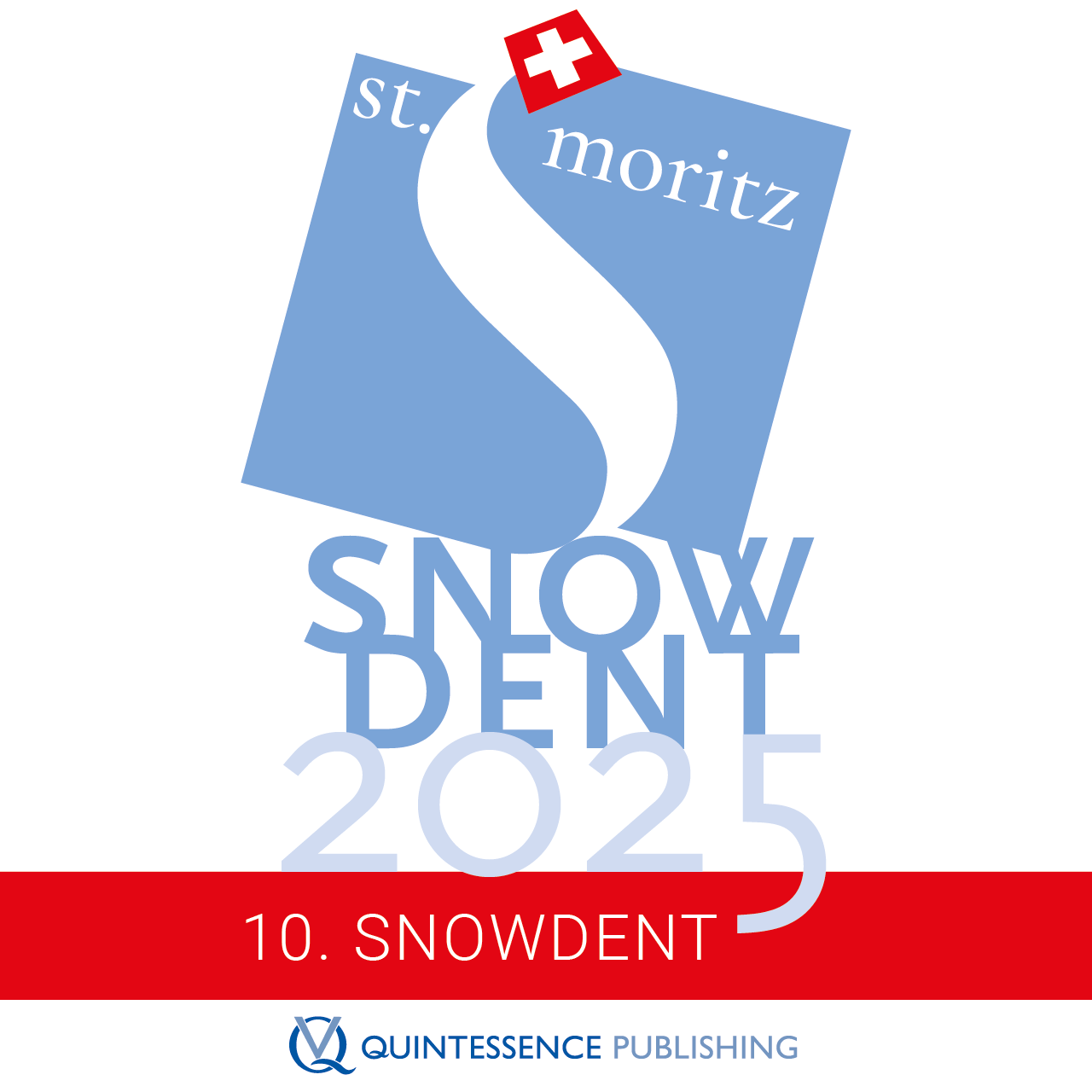The International Journal of Prosthodontics, Pre-Print
DOI: 10.11607/ijp.9279, PubMed ID (PMID): 3988864831. Jan 2025,Pages 1-32, Language: EnglishGehrke, Peter / Wasiluk, Grzegorz / Fischer, CarstenPurpose: To address the challenges of obtaining accurate digital impressions for the fabrication of fixed restorations on multiple implants in full-arch edentulous cases. Materials and Methods: An approach to the use of extended design scan bodies (EDSBs) and advanced digital technologies in full-arch implant rehabilitation is presented. Clinical and laboratory treatment sequences are illustrated, focusing on intraoral scanning, restorative materials, and digital fabrication techniques. Results: EDSBs provide accurate digital impression results, maintaining precision over longer distances and proving effective for both fixed and removable implant restorations. Conclusions: Using EDSBs with L-shaped and T-shaped extensions creates a stable reference framework during scanning, overcoming the lack of reliable landmarks on edentulous mucosa and enhancing digital impression accuracy and clinical outcomes.
Keywords: Complete-arch, edentulous, implant restorations, intraoral scanning, scan bodies, scan flag.
The International Journal of Oral & Maxillofacial Implants, 2/2025
DOI: 10.11607/jomi.11039, PubMed ID (PMID): 38941168Pages 207-217, Language: EnglishGehrke, Peter / Pietruska, Maria Julia / Korth, Anissa / Schöttler, Tanja / Jenatschke, Rafaela / Fischer, Carsten / Sader, Robert / Weigl, PaulPurpose: To retrospectively evaluate the long-term clinical, technical, biologic, and esthetic outcomes of implant-supported single zirconia crowns (ISCs) intraorally cemented to titanium-base (Ti-base) hybrid abutments up to 16 years after placement. Materials and Methods: A total of 63 ISCs were evaluated in 36 patients at two different private practices.Original Ti-bases were selected, and zirconia (Zr) mesostructures and Zr crowns were designed using CAD/CAM software and then milled from partially stabilized Zr blocks. After the mesostructures were cemented extraorally onto the Ti-bases, the Zr crowns were intraorally luted to the hybrid abutments. The Ti-base ISC restorations were followed for up to 16 years, and their clinical, biologic, and esthetic outcomes were recorded at distinct time points at 3-year intervals: October 2019 (T1) and October 2022 (T2). Results: A total of 36 patients (18 men, 18 women) received 32 ISCs in the anterior region and 31 ISCs in the posterior region of the maxilla and mandible. The mean follow-up of the Ti-base ISCs was 6.93 ± 2.60 years. The mean follow-up of the implants amounted to 8.11 ± 3.26 years. No implants were lost during follow-up, resulting in a cumulative implant survival rate of 100%. Abutment screw loosening was observed in two ISCs after 1 year of function. The overall cumulative restorative survival rate of the Ti-base restorations was 96.83%. At the T2 follow up, 24% of the ISCs exhibited an increase in probing depth (PD) despite maintaining clinically healthy peri-implant tissue. An 11% increase in bleeding on probing (BoP) and a 3.17% decrease in the plaque index (PI) were recorded. Despite spectrophotometrically measured ΔE values indicating visible discoloration of some restorations and their peri-implant soft tissue, a low incidence of esthetic complications was observed with an average pink and white esthetic score (PES/WES) of ≥ 12. No correlation was found between PES (R = –0.25; P = .27) and WES (R = –0.18; P = .43) scores and digital shade determination. Conclusions: The results indicate satisfactory clinical outcomes for intraorally cemented ISCs supported by Ti-base hybrid abutments. An overall esthetic superiority of Ti-base ISCs could not be confirmed.
Keywords: retrospective trial, titanium base, zirconia, two-piece hybrid abutment, implant-supported single crown.
QZ - Quintessenz Zahntechnik, 6/2024
StatementPages 684-686, Language: GermanFischer, CarstenZT Carsten Fischer über die Vorteile des Mikrolayerings und die Notwendigkeit, in der Zahntechnik flexibel zu bleibenQZ - Quintessenz Zahntechnik, 9/2022
ErfahrungsberichtPages 882-893, Language: GermanFischer, CarstenMikrolayering mit dem Keramikkonzept GC Initial IQ One SqinDer Beitrag zeigt, wie mit der Kombination aus der neuartigen Keramikmasse GC Initial IQ One Sqin (Fa. GC Germany, Bad Homburg) und modernen Gerüstwerkstoffen die Grundlage für ästhetische Restaurationen gelegt wird. Zudem wird diskutiert, welche Vorzüge sich aus einer minimalistischen Verfahrenstechnik ergeben und worauf bei der Anwendung dieser Technik im Laboralltag geachtet werden sollte.
Keywords: Mikrolayering, Verblendkeramik, Individualisierung, Farbbestimmung, Gerüstfarbe
The International Journal of Oral & Maxillofacial Implants, 4/2021
Online OnlyDOI: 10.11607/jomi.8537Pages e91-e96, Language: EnglishGehrke, Peter / Zimmermann, Kai-Peter / Weinhold, Octavio / Dhom, Günter / Fischer, Carsten / Sader, Robert
Purpose: The objective of this investigation was to assess the extent of mucosal discoloration caused by different CAD/CAM abutment materials and to determine the influence of mucosa thickness on the subsequent color, with a particular focus on titanium nitride.
Materials and methods: In a pig maxilla, a trapdoor-shaped mucosa flap was prepared unilaterally. Several CAD/CAM abutment materials were used to assess a number of clinical scenarios. Varying mucosa thicknesses were simulated by connective tissue grafts harvested at the contralateral side of the palate, resulting in layer thicknesses of 1.5, 2, and 3 mm. Titanium (Ti), zirconia (ZrO2), and titanium nitride (TiN) served as test specimens with and without ceramic veneering. Color differences (ΔE) and deviations in brightness (L), chroma (C), and hue (H) were determined spectrophotometrically, comparing the measured value of the native tissue and the results obtained with different materials at varying mucosa thicknesses.
Results: All tested specimens caused a mucosa discoloration in comparison to the native tissue, diminishing with increasing mucosa thickness. The use of TiN demonstrated the least mucosa discoloration in thin soft tissue of 1.5 mm, with a mean ΔE value of 1.93 (P = .004). While ZrO2 revealed a comparable ΔE value of 2.13 (P = .022) at a tissue thickness of 1.5 mm, Ti showed the highest mucosa discoloration above the visibility threshold of ΔE = 3.1, with a mean ΔE value of 4.07 (P = .002). Ceramic veneering of the Ti samples led to a considerable reduction in soft tissue discoloration, with a resulting ΔE value of 2.2. The veneering of TiN and ZrO2 samples with porcelain, on the other hand, had no noticeable effect on the mucosa color.
Conclusion: CAD/CAM abutment materials cause an adverse soft tissue color shift that decreases with increasing mucosa thickness. In thin peri-implant mucosa, titanium nitride and zirconia lead to the least discoloration. Due to their positive optical properties and mechanical superiority compared with ceramic abutments, gold-hue titanium nitride-coated CAD/CAM abutments could be a clinical alternative in cases of thin peri-implant mucosa.
Keywords: CAD/CAM abutment, gold hue, mucosa discoloration, peri-implant mucosa, spectrophotometer, titanium nitride
QZ - Quintessenz Zahntechnik, 4/2019
ErfahrungsberichtPages 518-522, Language: GermanFischer, CarstenVorstellung des PREMIO ULTRA von PrimotecDie Wahl des passenden Laborscanners wird von vielen Faktoren beeinflusst. Zusätzlich zu präzisen Scanergebnissen sind Flexibilität, Schnelligkeit, Offenheit und Komfort wesentliche Aspekte. Der Autor arbeitet im Laboralltag seit vielen Jahren mit digitalen Technologien und gilt u. a. im Bereich der zweiteiligen CAD/CAM-Abutments (Hybridabutments) als erfahrener Experte. Im Beitrag stellt er das Arbeiten mit dem PREMIO ULTRA-Laborscanner (Primotec, Bad Homburg) vor.
Keywords: Laborscanner, Effizienz, intuitive Bedienung, digitaler Workflow
QZ - Quintessenz Zahntechnik, 11/2019
WissenschaftPages 1368-1379, Language: GermanGehrke, Peter / Fischer, Carsten / Weinhold, Octavio / Dhom, GünterAktuelle LiteraturübersichtImplantataufbauten sind mehr als ein bloßes Kopplungselement zwischen dem osseointegrierten Implantatkörper und der prothetischen Suprakonstruktion. Sie gelten heute als wichtiger Faktor für den implantologischen Langzeiterfolg. Daher werden Abutments aus vielen Perspektiven intensiv untersucht. Relevante Forschungsergebnisse aus Klinik und Labor umfassen z. B. das Abutmentmaterial, die Implantataufbauverbindung, den Design- und Herstellungsprozess und die Kompatibilität der verschiedenen Systeme. Diese Ergebnisse führen zu einer Fülle von Informationen über ästhetische, biologische und mechanische Eigenschaften. Der vorliegende Beitrag gibt eine aktuelle Übersicht zur wissenschaftlichen Datenlage von Implantabutments, zu ihrer Biege- und Bruchfestigkeit sowie zu ihrer klinischen Langzeitbewährung.
Keywords: Implantatprothetik, Werkstoffe, Aufbauten, Abutments, Evidenz
QZ - Quintessenz Zahntechnik, 4/2018
ExpertenstatementPages 547-554, Language: GermanFischer, Carsten / Ellmann, Daniel / Zacharias, Norman / Neumann, Thomas / Hannker, Christian / Stanger, Hans-Ullrich / Hopp, MichaelThe International Journal of Oral & Maxillofacial Implants, 4/2018
DOI: 10.11607/jomi.6131, PubMed ID (PMID): 30024996Pages 808-814, Language: EnglishGehrke, Peter / Sing, Thorsten / Fischer, Carsten / Spintzyk, Sebastian / Geis-Gerstorfer, JürgenPurpose: Central manufacturing of two-piece computer-aided design/computer-aided manufacture (CAD/ CAM) zirconia abutments may provide a higher accuracy of internal and external adaptation at the expense of delayed restoration delivery. The aim of this study was to compare the fit of two-part zirconia abutments that were either fabricated centrally with the DEDICAM system or at a local laboratory. The field of interest was the marginal, external, and internal luting gap between the titanium insert and CAD/CAM zirconia coping.
Materials and Methods: Two groups of nine two-piece CAD/CAM zirconia hybrid abutments were subjected to scanning electron microscopy (SEM) to evaluate the precision of fit and thickness of the adhesive joint. Control specimens were fabricated with the CAMLOG DEDICAM system at the manufacturer's site; the test specimens were produced in a local laboratory. After embedding all samples (n = 18) in resin, they were sectioned, and the external, marginal, and internal luting gaps between the titanium base and zirconia coping were measured with SEM. Welch's t test was used for statistical analysis of the obtained data.
Results: The overall range of measured gaps between the components of two-piece CAD/CAM zirconia abutments was 0 to 115.5 μm; the mean overall gap size and standard deviation was 45.61 ± 5.88 μm and showed no appreciable difference between the test and control groups. The mean sizes of the marginal/ external and internal gaps showed only negligible differences. The internal gap size was generally larger and showed a higher variability than the marginal/external gaps, albeit on a very low level. None of the reported differences between the test and control specimens were statistically significant.
Conclusion: Luting-gap sizes of CAMLOG DEDICAM- and locally fabricated CAD/CAM zirconia hybrid abutments showed no appreciable difference. Both configurations of two-piece abutments provided a highly precise fit of hybrid components, overmatching the high-quality standards in CAD/CAM implant-based prosthetic dentistry.
Keywords: full ceramic, hybrid abutments, internal fit, luting gap, marginal fit, two-piece CAD/CAM zirconia abutments
QZ - Quintessenz Zahntechnik, 3/2018
Step by StepPages 338-352, Language: GermanRinke, Sven / Fischer, CarstenEmpfehlungen zur klinischen und zahntechnischen UmsetzungExtendierte keramische Veneers sind bei einer geeigneten Indikationsstellung eine sinnvolle Alternative zu klassischen Vollkronen. Zur Vermeidung materialbedingter Versagensfälle sollten ausschließlich hochfeste Glaskeramiken (mittlere Biegefestigkeit > 350 MPa) genutzt werden, die Restaurationen erfordern außerdem eine volladhäsive Befestigung. Das durch die erhöhte Dentinexposition bestehende Risiko eines Retentionsverlustes sollte durch Präparationsmodifikationen im inzisalen Bereich (inzisale palatinale Hohlkehle) reduziert werden.
Keywords: Keramikveneer, Glaskeramik, Lithiumdisilikatkeramik, klinische Bewährung












